Podcast equipment and setup: These terms cover such a wide variety of gear, as well as all the other bits and pieces needed to make a room sound good. It’s easy to imagine a pro-level radio studio filled with lots of intimidating (and very expensive) equipment. But for the vast majority of creators, that looks nothing like their own podcast setup.
Table of Contents
You can break podcast equipment down into categories, based on how you record and capture your voice, from mic to mixer to recorder to computer.
The recording process can be made as simple or as complicated as you like. You can record right into your computer, ridding yourself of the need for a mixer or a recorder. Or you can go the full studio route, and use all four.
If you use very little kit, the process will be simple, but you’ll also have less flexibility and control. This isn’t an issue for most aspiring podcasters, though, as they’ve no intention of becoming an audio engineer – they just want to get their message out there.
If you fall into that bracket, then this podcast equipment and setup guide is for you. Here, we’ll take a look at what you might need, and why you might need it when you’re planning to start your first podcast…
If you need to zoom out first, go here to see everything you need to record a podcast, from planning to software.

Editor’s Note
Our ‘Best Podcast Equipment & Setup’ guide was originally written in 2014. We update this post periodically to reflect changes in technology, our recommendations, and because we’re always learning new things!
Types of Podcast Equipment (And Why You Might Need Them)
Let’s run through the various pieces of equipment commonly used to record a podcast, then. We’ll start with the microphone, then take a look at things like recorders, USB interfaces, and even headphones. Let’s dive in…
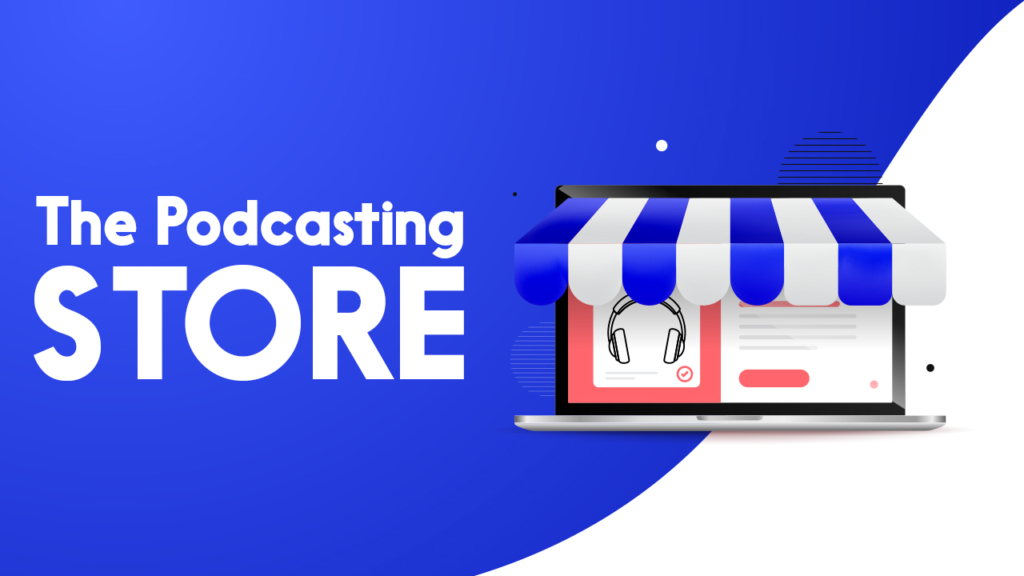
Check out The Podcasting Store for a curated list of podcast equipment, featuring at-a-glance prices and ratings!
The Microphone: Podcast Equipment & Setup
When you think about a microphone, you might imagine the typical musician’s mic. And, whilst you can absolutely use one of these to podcast, it’s worth noting that mics come in many forms, shapes, and sizes.
The bottom line is that a microphone is simply the tech needed to “hear” your voice and send it onward to be recorded somewhere. This makes it the first part of our recording “chain.”
So what options are available to us when thinking about our microphone?
Here are the main types, with links to our guides. Or, read on to get a summary.
- Read More: Best Microphones of every kind
- Read More: Best USB Microphones for Podcasting
- Read More: Best Headset Microphones
USB Mics
A common and simple piece of podcast equipment is the USB microphone. Often these are condenser microphones, which plug straight into your computer. USB mics are ideal for beginners, especially folks who do solo/monologue-style shows, and those running online interview podcasts. Check out our USB mics roundup to have a look through our favourite options on that front.
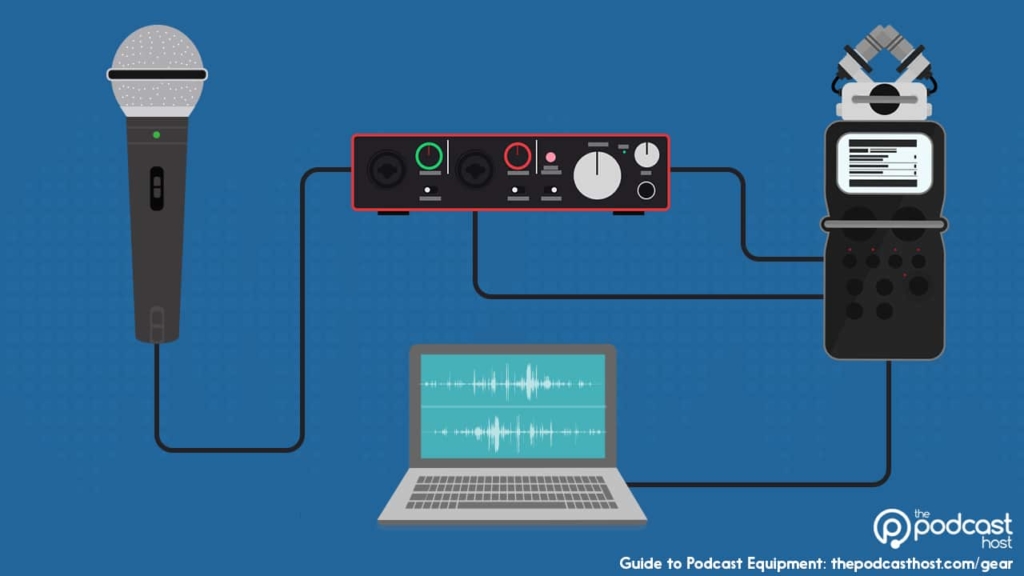
XLR Mics
XLR mics need additional equipment to run them. They don’t plug straight into your computer, but instead, go into an interface, mixer, or digital recorder (more on these all later).
You can actually get interfaces, mixers, and digital recorders in USB form though, so you can run an XLR mic into your computer, just not directly.
XLR mics are suited to folks who want premium sound quality, and a lot more production flexibility, as well as those who don’t want to be tied to a computer at all times. Check out the best podcasting mics roundup for our top picks there.
It’s a good idea to look for microphones that include both a shock mount and a built-in pop filter. Or, you might think about tagging a stand-alone double-layer pop filter onto your purchase. These two tools are incredibly valuable for podcasters who are working at the same desk they’re recording from and will help eliminate unwanted noise.
Recording Devices That Include Mics
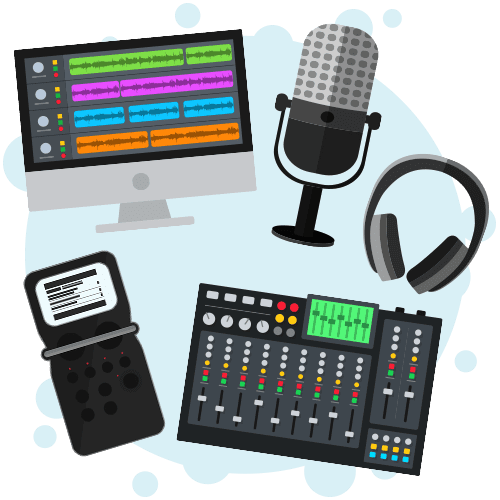
You probably already carry a mic around with you in the form of your smartphone. You can turn this into a podcast setup by adding the Rode SmartLav+ and SC6. This kit is ideal for on-the-go recording and location interviews.
Alternatively, there are a lot of high-quality digital recorders on the market. You can record directly into these, or plug additional mics into them. Again, these are a great option for someone who’s looking for a flexible and portable setup.
The Recorder: Podcast Equipment & Setup
And speaking of digital recorders, we now need a podcast equipment option for actually capturing and storing your audio. This could be anything from a phone, to a computer, to a dedicated digital recorder itself.

Digital Recorders
A dedicated digital recorder is a great option for someone who wants to podcast on the go but is looking for a level of sound quality above what you’ll get with a smartphone.
On top of that, digital recorders offer a lot more settings and options for creating audio, because that’s what they’re literally built for. You don’t even necessarily need an additional mic to record into one because most of them come with built-in mics. Additional benefits include built-in SD card slots and multiple input(s). The SD cards can be handy when you want to quickly drop some audio files over to your desktop and can’t be bothered to relocate and plug in all your equipment.
Computers
There are a plethora of options available to you when it comes to recording directly into a computer. You can use a DAW (Digital Audio Workstation) like Audacity or Adobe Audition (check out our comparison of the two!), for starters. Or, if you’re looking to record online/remote interviews, there are many call recording options on the market nowadays too. Check out our podcast software guide for more on this front.
You also might want to take a look at our best computers and best laptops for podcasting, if you’re in the market for something optimal.
Smartphones
There are a tonne of recording apps out there that’ll enable you to record directly into your phone. You probably have a default recording app on there already, but here are a few options if you’re looking to upgrade your sound and range of flexibility.
Recording into a phone can be really convenient, though it lacks the flexibility and options of a dedicated digital recorder. Nevertheless, it’s often a great starting point for many, and you can always upgrade your equipment further down the line.
Interfaces & Mixers: Podcast Equipment & Setup
You don’t actually need an interface or mixer to podcast, but many podcasters do still utilise them. So why might you consider getting one?
- If you want to use an XLR mic.
- If you want to use multiple mics.
- If you want to record live, or “as live” – with all your music, SFX, etc. played in real-time.

My favourite interface is a little USB device called the Focusrite Scarlett 2i2, but there are other good audio interface options for podcasters on the market, too.
On the mixer front, there’s a growing argument that they’re no longer necessary for podcasters who want all of the features listed above. Podcast-specific devices like the Zoom PodTrak P4 and Rode Rodecaster are much better options these days, in my opinion. That said, if a mixer is still something you’d like to shop around for, here’s our best podcast mixers roundup which will give you a few options.
Headphones: Podcast Equipment & Setup
Headphones are a vital part of the podcast equipment lineup.
You should always monitor your recordings, even when doing a solo show. This means using headphones whilst recording so you can hear exactly what’s being captured. The benefit of doing this is that if there are issues, you can fix them right away.
You’ll also need headphones to hear your guest if you run an online interview show. They come in handy for listening back to recordings, and for editing audio too. Check out our best podcast headphones roundup for a few great options there.
What About the Room Itself?
You can have the best podcast equipment and setup in the world, but if you stick it all in a poor quality room, your show will sound terrible.
Treating your room for reverb is key. We have a full guide to setting up your podcast home studio that includes everything from utilising acoustic blankets to popping your mic into a simple cat bed or building a “cloffice“. Of course, you’ll want to eliminate unwanted background noise as much as possible, too.
Bottom line – if you get your environment on-point, even the most no-frills budget podcast setup can sound top class.
Production & Publishing
Once your podcast has been recorded, you have the option to edit it. How much editing (if any!) you do, is entirely up to you. See how much editing should I do in my podcast? for more on that.
When we get to this stage, the “podcast equipment” side of things is really just as simple as a computer or laptop. It’s what software and tools you use on your machine that you need to give thought to.
If you’re doing any sort of editing, you can choose one of the many software options out there. I’ve mentioned DAWs (Digital Audio Workstations) like Audacity and Adobe Audition already, and these are both great post-production options.
If you want to do some editing, as well as add in some intro and outro music, but you don’t want to learn how to use a DAW, then check out Alitu. Alitu is an app we’ve created that makes it easy to record, produce, and publish your podcast, even if you know nothing about audio. Again, you’ll just need a computer to run it.

Let Alitu Take Care of Your Podcast Editing
Alitu is a tool that takes your recording, polishes it up, adds your music, and publishes the episode, all automatically.
Learn more about Alitu
Finally, we get to the uploading stage. In order to publish your podcast for the world to hear, you need to sign up to a media hosting provider. This is basically where your podcast lives online, and the hub where places like Apple Podcasts and Spotify will look to pull all your content from.
You’ll find our favourite media hosting options right here. Each one has its own unique features and there’s something there to suit any podcaster, no matter their skill level, motivation, or budget.
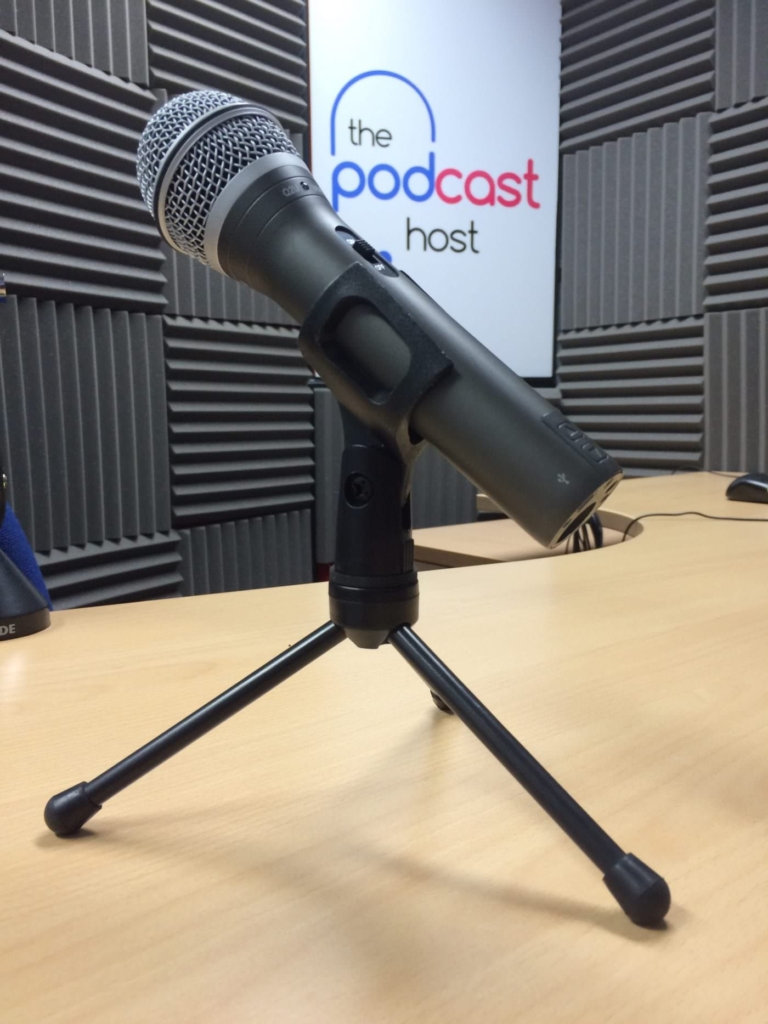
Podcast Equipment Is a Means to an End
I mentioned already that most people don’t get into podcasting to collect loads of fancy and expensive audio equipment. Some folks do end up doing that, of course, but you definitely don’t need to.
It’s better to start simple so you can focus on your actual content, rather than whether or not your long chain of gear is all working correctly. Over time, as you grow, you can tweak and upgrade things here and there.
Summary: Best Podcast Equipment & Setup for Beginners & Pros Alike
Let’s sum things up by going full if…then. Here’s how you can decide what gear you need:
1. If you’re recording solo, or recording interviews online, then:
Get a Samson Q2U mic
2. If you’re recording 2 people in-person, on a budget, then:
3. If you’re recording 2 or more people in-person, either on-the-go or in-studio, and have the budget for high quality, then:
Get 2 or more Shure SM58s and the Zoom PodTrak P4
The Samson Q2U is our most recommended mic and suits 90% of new podcasters perfectly. It functions as both a USB and XLR mic, so, if you decide to upgrade to a recorder or interface further down the line, it’ll work with them too. It’s also excellent value, and well within most folks’ budgets. You’ll often find the Q2U available in bundle deals with other podcast equipment such as a boom arm, pop filter, and headphones. This makes for an ideal podcast starter kit.
Aside from that, it’s hard to make any one-size-fits-all recommendations because there are so many variables. But remember, when it comes to recording, editing and publishing then be sure to check out our podcast production app Alitu.
And, if you’re looking for more help or guidance towards any aspect of podcasting equipment, or otherwise, then have a look at The Podcast Host Academy – that’s where we run weekly live Q&A sessions, and have video courses on everything from presentation and editing skills, to audience growth and monetisation!
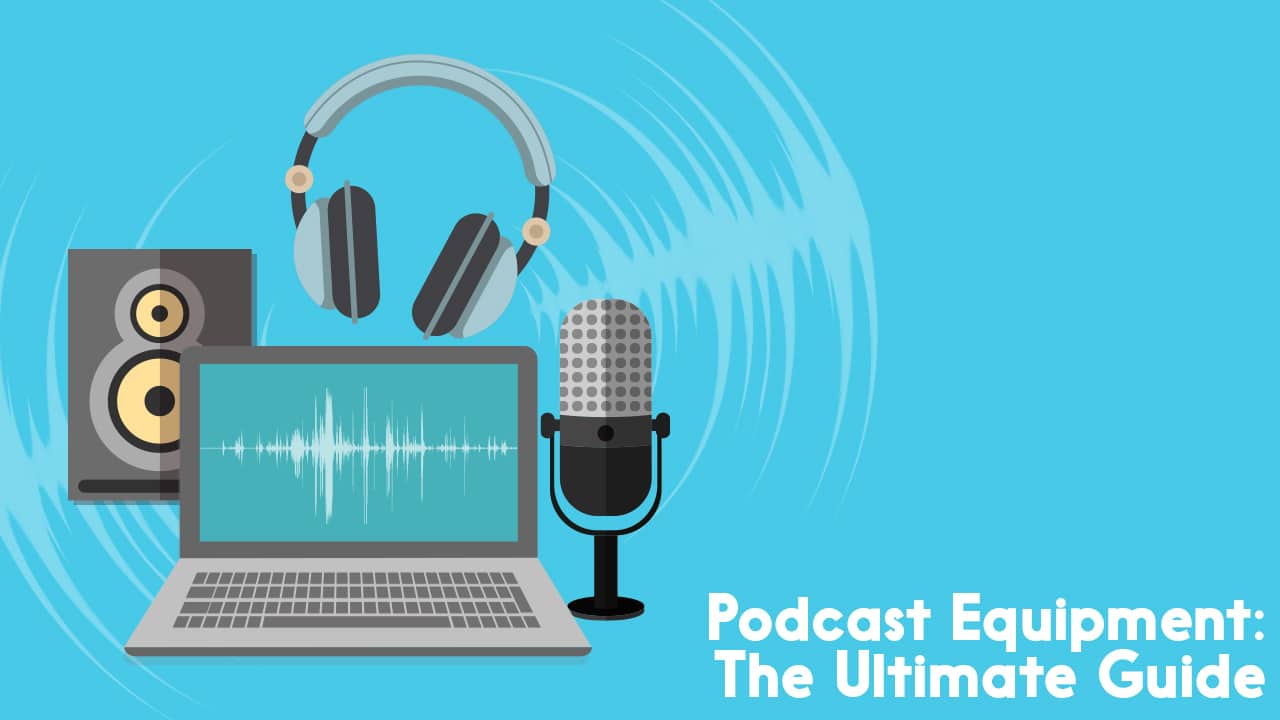
What Our Readers Think About Best Podcast Equipment & Setup for Beginners & Pros Alike
Hi, thanks for your very helpful advice and guidance. I came across you through your ebook originally, which was just what I was looking for. I ended up following your advice and purchased a Roland R-05, but I haven’t been that happy with the sound, which seems a bit tinny. I don’t have a particularly discerning ear and recordings are fine to use, but I think I must be using the ring settings. I followed their instructions for recording a meeting (high mic gain, AGC on, low cut on and so on) but perhaps that is the wrong approach?
Thanks for any pointers you have,
Colin.
Hi Colin, thanks for getting in touch. And great name by the way 😉
The Roland is a great little recorder, recommended by quite a few top podcasters, but you’re right, it’s not perfect in all circumstances. Can you tell me what the recording environment is like? Where are you recording this audio?
The microphone on the Roland itself is good, but it’s not as good as a decent quality standalone mic. It’s often best to pair it with an external one if you want the very best quality. For example, get yourself a Shure SM58 and plug that into the Roland for a bomb proof hand-held solution, or get a decent little lavalier mic and attach that to your subject’s shirt.
Hope that helps!
Colin
Hello, thank you for your great and helpful article. Altogether, this setup would run about $160 on Amazon. Alternatively, there is a kit for smartphones for $30 (Movo Executive Lavalier Clip-on Interview Microphone with Secondary Mic & Headphone Monitoring Input), and the reviews on Amazon are strong.
Would you recommend against this option?
P.s. I’m brand new to podcasting and am looking for the cheapest and simplest way to get out of the gate. Thanks again for your help.
Hi Nelson. I can’t personally vouch for the particular model you mention as I haven’t used it. This article might be useful though in searching for a low-cost kit https://www.thepodcasthost.com/equipment/how-much-spend-podcast-equipment/
Hello,
Thank you for this article. I plan to work with adobe audition, do I still need a mixer for recording (pc / audio device / smartphone) ?
Regards,
Hi
Great general article Matthew.
That you did not mention the most obvious software for and vocal digital audio project or podcast is disappointing. HINDENBURG JOURNALIST has got soo much going for it.
Hi Matthew
Thanks for another excellent article. I have a Samson 2QU, and find it’s too sensitive to background noise, even with a pop filter and foam cover. Recording direct into my Dell laptop via Audacity also picks up the PC noise (fan etc). I have a Zoom H4N so record into that, with a cable feed from the PC to record my interviewee over VOIP. I’ve had to force the PC to use the inbuilt mic, as the Samson plugged into the H4N at the same time created horrendous feedback. You can only power the Samson from a USB port (not mains etc).
Podcast launching soon after I’ve cleaned up all the audio!!
Does anyone have a complete list of what equipment is needed for a brand new podcast?
I think this article pretty much sums it up!
Found this very good in explaining to the uninitiated what equipment is involved in podcasting.
Great information. Thanks for sharing. I am looking to start a podcast with a co-host in another state. What is the most cost effective equipment we both will have to have in each location and is it possible to do and can we accomplish this with an online solution? Thanks in advance.
Absolutely possible. Many of the podcasts I work with involve remote hosting. I highly recommend using a service like Zoom or Zencastr to do the initial recording over the internet. Both services allow you to save individual files for later editing. As for equipment, each of you would need a good USB microphone like the Samson Q2U, headphones like the ATH-30s from Audio Technica and computer with an internet connection.